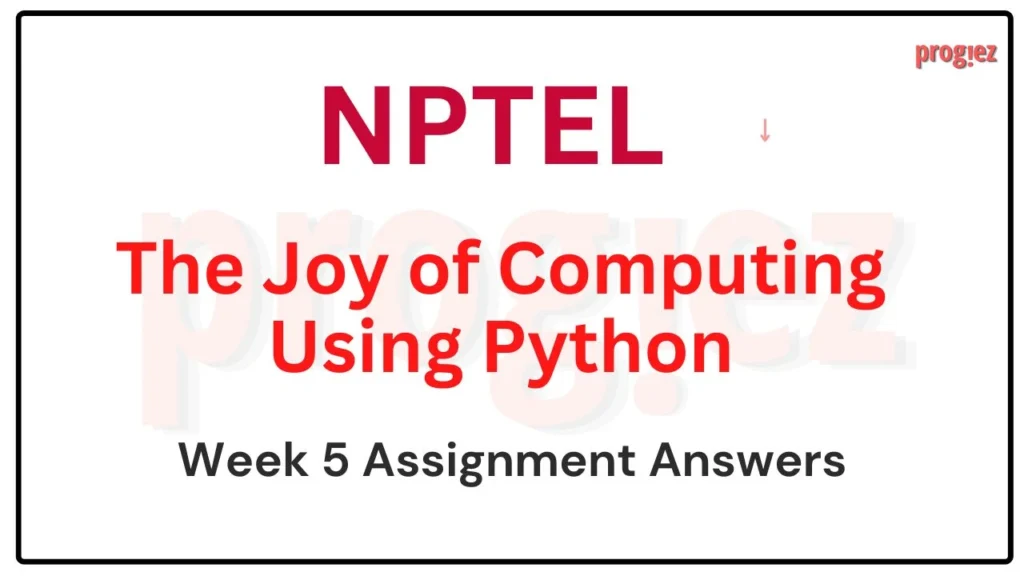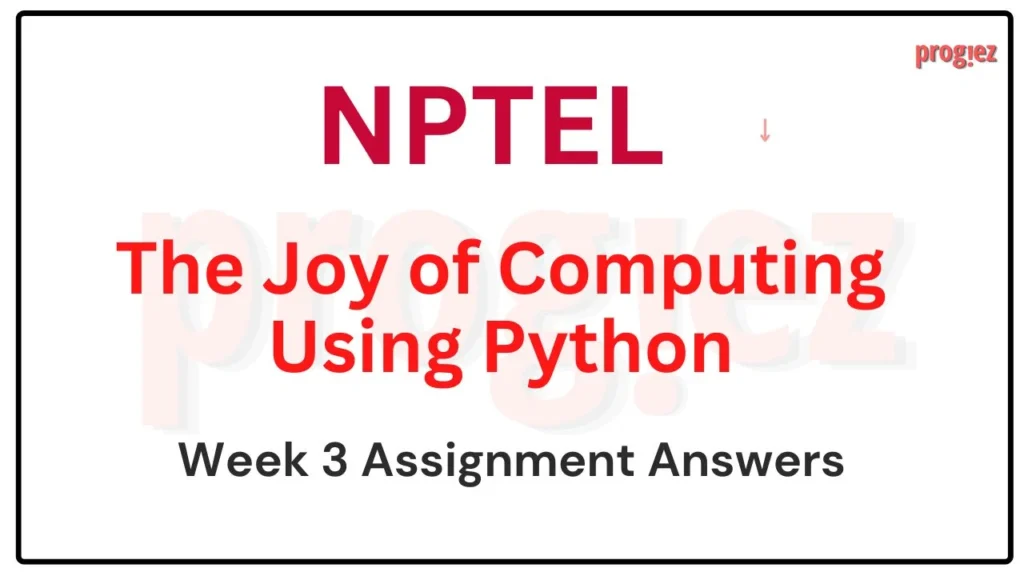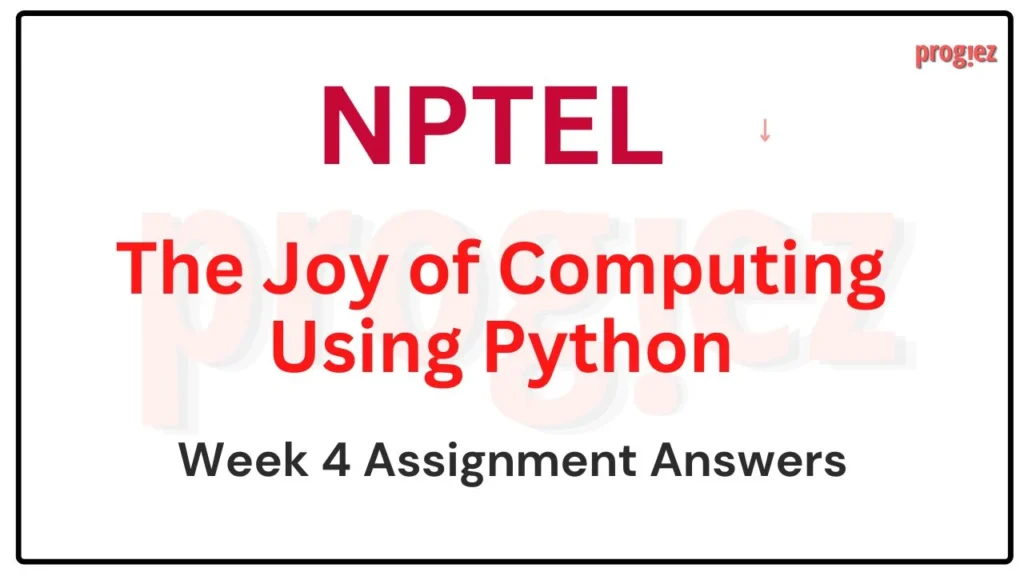The Joy of Computing Using Python NPTEL Week 5 Answers
Are you looking for The Joy of Computing Using Python NPTEL Week 5 Answers? You’ve come to the right place! Access the latest and most accurate solutions for your Assignment 5 in The Joy of Computing Using Python course
Table of Contents

The Joy of Computing Using Python NPTEL Week 5 Answers (Jan-Apr 2025)
Course Link: Click Here
Q1. Which of the following is the correct way to add data with key as CS102 and value as “Database Management Systems” to a dictionary named courses?
a) courses["CS101"] = ("Database Management Systems")
b) courses["CS102"]["Database Management Systems"]
c) courses["CS102"] = "Database Management Systems"
d) courses["CS101"] = "Database Management Systems"
Q2. What is the probability of Monty not opening the door with a goat, given the hypothesis that you initially chose the door which has a car?
a) 0
b) 0.5
c) 1
d) 0.33
Q3. What should be replaced with ? in line 10, so that there is a high chance that final_choice is equal to 2?
a) 2
b) 2**(1024) % 2 != 0
c) 2*(2**(89) + 7) % 2 == 0
d) (2**(90)) % len(doors) != 1
Q4. Given that you have a sorted list of 2048 elements, what is the maximum number of comparisons to search such an element using linear search? Can binary search do it in fewer comparisons?
a) Yes, binary search can do it more efficiently, linear search takes 1024 comparisons
b) Yes, binary search can do it more efficiently, linear search takes 2048 comparisons
c) No, binary search may/may not do it more efficiently, linear search takes 1024 comparisons
d) No, binary search will take more comparisons, linear search takes 2048 comparisons
Q5. What is the primary use of a file with a .wav or .wave extension?
a) Storing video recordings
b) Storing log files
c) Storing waves of files
d) Storing audio recordings
Q6. What does this program print in the end?
a) Fraction of throws where both players showed different symbols (rock/paper/scissors)
b) Fraction of throws where both players showed rock
c) Fraction of throws where both players showed the same symbol (rock/paper/scissors)
d) Fraction of throws where both players showed paper
Q7. In binary search, the list gets divided in every iteration to find the element.
a) True
b) False
Q8. Which of the following are requirements for binary search to work correctly?
a) The list can be unsorted.
b) The list must contain only positive integers.
c) The list must be sorted.
d) The list must have no duplicate values.
Q9. Given an array [4, 2, 7, 1, 3], what will be the array after the third pass of Bubble Sort?
a) [1,3,2,4,7]
b) [2,4,1,3,7]
c) [1,2,3,4,7]
d) [2,1,3,4,7]
Q10. How many swaps are performed in iteration 3 for bubble sorting the list [5,4,3,2,1]? Enter 0 if the list is sorted in less than 3 iterations.
The Joy of Computing Using Python NPTEL Week 5 Answers (July-Dec 2024)
1. Which of the following is the correct way to add data with key as CS101 and value as “Web Programming” to a dictionary named courseData?
a) courseData["CS101"].append("Web Programming")
b) courseData["CS101"]["Web Programming"]
c) courseData["CS101"] = "Web Programming";
d) courseData["CS101"] = "Web Programming"
Answer: c) courseData["CS101"] = "Web Programming";
2. What is the probability of Monty opening the door with goat, given the hypothesis that you initially chose the door which has car?
a) 0.5
b) 0.66
c) 0.33
d) 1
Answer: d) 1
3. What should be replaced with ? in line 10, so that there is high chance that final_choice is equal to 2?
a) True
b) (2**90) % 2 == 0
c) 3**(3**89) + 3 ) % 3 == 0
d) (2**90 ) % len(doors) == 1
Answer: a) True
b) (2**90) % 2 == 0
c) 3**(3**89) + 3 ) % 3 == 0
d) (2**90 ) % len(doors) == 1
4. Given that you have a sorted list of 1024 elements, what is the maximum number of comparisons required to find the target element using binary search? Also, what is the number of comparisons to search such an element using linear search?
a) Binary: 10, Linear: 512
b) Binary: 11, Linear: 1024
c) Binary: 10, Linear: 1024
d) Binary: 11, Linear: 512
Answer: c) Binary: 10, Linear: 1024
5. What type of data is contained in a file with a .wav or .wave extension?
a) Log data
b) Audio data
c) Video data
d) Image data
Answer: b) Audio data
6. What does this program print in the end?
a) Fraction of throws where both players showed different symbol (rock/paper/scissors)
b) Fraction of throws where both players showed rock
c) Fraction of throws where both players showed the same symbol (rock/paper/scissors)
d) Fraction of throws where both players showed paper
Answer: c) Fraction of throws where both players showed the same symbol (rock/paper/scissors)
7. In binary search, what happens if the target value is greater than the middle element of the array?
a) The search continues in the left half of the array
b) The search continues in the right half of the array
c) The search ends
d) The array is sorted again
Answer: b) The search continues in the right half of the array
8. Which of the following is a requirement for binary search to work correctly?
a) The list must be sorted
b) The list must contain only positive numbers
c) The list must be of an even length
d) The list must contain unique elements
Answer: a) The list must be sorted
9. Given an array ([5, 3, 8, 4, 2]), what will be the array after the third pass of Bubble Sort?
a) [3, 2, 4, 8, 5]
b) [3, 2, 4, 5, 8]
c) [2, 3, 4, 5, 8]
d) [3, 5, 2, 4, 8]
Answer: b) [3, 2, 4, 5, 8]
10. How many swaps are performed in iteration 3 for bubble sorting list [4,3,2,1]? Enter 0 if the list is sorted in less than 3 iterations.
Answer: 1
All Weeks of The Joy of Computing Using Python: Click here
For answers to additional Nptel courses, please refer to this link: NPTEL Assignment Answers
The Joy of Computing Using Python NPTEL Week 5 Answers(JAN-APR 2024)
Course Name: The Joy of Computing using Python
Course Link: Click Here
For answers or latest updates join our telegram channel: Click here to join
These are The Joy of Computing Using Python NPTEL Week 5 Answers
Q1. Imagine the Monty Hall problem had four doors instead of three, and Monty opened one door to reveal a goat after your initial choice, what would be the probability of winning the car by switching?
1/2
1/3
1/4
3/4
Answer: 3/4
Q2. What happens if you try to add a new key-value pair to a dictionary using a key that already exists in the dictionary?
The new value overwrites the existing value
An error is raised
The dictionary becomes immutable
The new value is appended to the existing value
Answer: The new value overwrites the existing value
For answers or latest updates join our telegram channel: Click here to join
These are The Joy of Computing Using Python NPTEL Week 5 Answers
Q3. The extended version of “Rock, Paper, Scissors” with “Lizard” and “Spock” was popularized by the TV show “The Big Bang Theory.” Here are the rules for “Rock, Paper, Scissors, Lizard, Spock”:
Rock wins against Scissors.
Scissors wins against Paper.
Paper wins against Rock.
Rock wins against Lizard.
Lizard wins against Spock.
Spock wins against Scissors.
Scissors wins against Lizard
Lizard wins against Paper
Paper wins against Spock.
Spock wins against Rock.
Each option can defeat two other options, lose to two other options, and draw with one other option.
What would be the possible change in steps for running “Rock, Paper, Scissors, Lizard, Spock”?
Step 1 would involve assigning 5 values to choices instead of 3
The bitwise operations involved in Step 3 would involve modulo operation with 5 instead of 3
None of the above
All the above
Answer: All the above
Q4. How does Bubble Sort compare elements in an array?
Compares adjacent elements and swaps if they are in the wrong order
Compares random elements in the array
Compares all elements with the first element
Compares elements in reverse order
Answer: Compares adjacent elements and swaps if they are in the wrong order
For answers or latest updates join our telegram channel: Click here to join
These are The Joy of Computing Using Python NPTEL Week 5 Answers
Q5. To sort a list in ascending order when does Bubble Sort exhibit poor performance?
When the list is sorted in ascending order
When the list is sorted in descending order
When the list contains unique elements
Bubble Sort always exhibits poor performance
Answer: When the list is sorted in descending order
Q6. How many passes does Bubble Sort make through the array in the worst-case scenario for sorting n elements?
n
n-1
2n
n2
Answer: n-1
For answers or latest updates join our telegram channel: Click here to join
These are The Joy of Computing Using Python NPTEL Week 5 Answers
Q7. How many pairs of adjacent elements are compared in a single pass of the bubble sort algorithm?
n
n-1
n/2
2n
Answer: n-1
Q8. The following steps are required to implement the binary search for an array sorted in ascending order.
Which steps would require modification if the array were sorted in descending order?
Step 2
Step 4
Steps 2 and 4
No modification in steps
Answer: Step 4
For answers or latest updates join our telegram channel: Click here to join
These are The Joy of Computing Using Python NPTEL Week 5 Answers
Q9. Select the correct statements among the following
A. In the presence of duplicate elements in a list, binary search always finds the first occurrence of the element in the list
B. In the presence of duplicate elements in a list, binary search may or may not find the first occurrence of the element in the list
C. In the presence of duplicate elements in a list, the existing binary search algorithm with minor modifications can be used to find the first occurrence of the target element in the list
D. In the presence of duplicate elements in a list , the existing binary search can be used to find any kth(k can be any number from 1 to number of times the element has been repeated) of target element in the list
Answer: B, C
Q10. Swapping of two numbers is an intermediate step in any sorting algorithm, In the lecture we use a temporary variable to swap two elements in the list.
Can swapping of two numbers be done without using a temporary variable?
Yes
No
Depends on size of list
Depends on nature of elements in the list
Answer: Yes
For answers or latest updates join our telegram channel: Click here to join
These are The Joy of Computing Using Python NPTEL Week 5 Answers
Programming Assignment
Question 1
Write a function insert that accepts a sorted list L of integers and an integer x as input. The function should return a sorted list with the element x inserted at the right place in the input list. The original list should not be disturbed in the process.
- The only built-in methods you are allowed to use are append and remove. You should not use any other method provided for lists.
- You do not have to accept input from the user or print output to the console. You just have to write the function definition.
Solution:
def insert(L, x):
"""
insert an element x into a sorted list L
Arguments:
L: list
x: integers
Return:
sorted_L: list
"""
M=L[::]
M.append(x)
return(sorted(M))For answers or latest updates join our telegram channel: Click here to join
These are The Joy of Computing Using Python NPTEL Week 5 Answers
Question 2
Accept a sequence of words as input. Create a dictionary named real_dict whose keys are the letters of the English alphabet. For each key (letter), the corresponding value should be a list of words that begin with this key (letter). For any given key, the words should be appended to the corresponding list in the order in which they appear in the sequence. You can assume that all words of the sequence will be in lower case.
You do not have to print the output to the console.
Solution:
words=input().split(",")
#print("words is ",words)
real_dict={}
k=list("abcdefghijklmnopqrstuvwxyz")
for w in words:
if w[0] not in real_dict:
real_dict[w[0]]=[w]
else:
real_dict[w[0]].append(w)For answers or latest updates join our telegram channel: Click here to join
These are The Joy of Computing Using Python NPTEL Week 5 Answers
Question 3
Consider a grid-world of size n×n. You are at the bottom-left corner, at the cell (1,1), to start with. A sample grid-world for the case of n=5 is given below for your reference:
You can move one step at a time in any one of the four directions: “North”, “East”, “West”, “South”. At every cell of the grid, all four moves are possible. The only catch is that if you make a move that will take you out of the grid at a border cell, you will stay put at the same cell. Concretely, if you are at the cell (1,4) and try to move west, you will remain at the same cell. Or if you are at (3,1) and try to move south, you will remain there.
Write a function named final that accepts a positive integer n and a sequence of moves (string) as arguments and returns the final position where you would end up in an n×n grid-world if you start at (1,1). You must return a tuple of size 2, where the first element is the x-coordinate and the second is the y-coordinate.
You do not have to accept input from the user or print output to the console. You just have to write the function definition.
Solution:
def final(n, moves):
x, y = 1, 1 # Starting position at (1,1)
for move in moves:
if move == "N" and y < n:
y += 1
elif move == "E" and x < n:
x += 1
elif move == "S" and y > 1:
y -= 1
elif move == "W" and x > 1:
x -= 1
return (x, y)For answers or latest updates join our telegram channel: Click here to join
These are The Joy of Computing Using Python NPTEL Week 5 Answers
More Weeks of The Joy of Computing Using Python: Click here
More Nptel Courses: Click here
The Joy of Computing Using Python NPTEL Week 5 Answers (JULY-DEC 2023)
Course Name: The Joy of Computing using Python
Course Link: Click Here
These are The Joy of Computing Using Python NPTEL Week 5 Answers
Q1. Which is the fastest sorting algorithm?
Bubble Sort
Bucket Sort
Quick Sort
Insertion Sort
Answer: Quick Sort
Q2. How can you remove all items from a dictionary?
dict.clear()
del dict
dict.remove_all()
dict.pop()
Answer: dict.clear()
Q3. What happens if you try to add a new key to a dictionary that already exists?
The key and its associated value will be updated.
The key and its associated value will be added.
The key will be added, but the associated value will remain unchanged.
An error will occur.
Answer: The key and its associated value will be updated.
These are The Joy of Computing Using Python NPTEL Week 5 Answers
Q4. Which of the following is true about dictionaries?
There can be multiple same keys.
Every value must be unique.
Every key must be unique.
We can’t get every key from the dictionary.
Answer: Every key must be unique.
Q5. What is the syntax to create a dictionary?
D = []
D = {}
D = ()
D = dictionary()
Answer: D = {}
Q6. What will be the output of the following code?
‘a’ ‘b’ ‘c’
20 30 50
(‘a’, 20), (‘b’, 30), (‘c’, 50)
(‘a’, ‘b’, ‘c’) (20, 30, 50)
Answer: (‘a’, 20), (‘b’, 30), (‘c’, 50)
These are The Joy of Computing Using Python NPTEL Week 5 Answers
Q7. In the Monte Hall Problem, what is the probability of winning if you switch doors after the host reveals a goat behind one of the other doors?
1/3
1/2
2/3
3/4
Answer: 2/3
These are The Joy of Computing Using Python NPTEL Week 5 Answers
Q8. In the Monte Hall Problem, what is the probability of winning if you do not switch doors after the host reveals a goat behind one of the other doors?
1/3
1/2
2/3
3/4
Answer: 1/3
These are The Joy of Computing Using Python NPTEL Week 5 Answers
Q9. What is the name of the game show that the Monte Hall Problem was based on?
Jeopardy
Wheel of Fortune
The Price is Right
Let’s Make a Deal
Answer: Let’s Make a Deal
These are The Joy of Computing Using Python NPTEL Week 5 Answers
Q10. Which module in Python can be used for Speech to Text conversion?
SpeechRecognition
PyAudio
Wave
all of the above
Answer: SpeechRecognition
These are The Joy of Computing Using Python NPTEL Week 5 Answers
Programming Assignment
Question 1
You are given a string S. Write a function count_letters which will return a dictionary containing letters (including special character) in string S as keys and their count in string S as values.
(input and output will be handled by us you just need to write the function and return the dictionary)
Input
The Joy of computing
Output
{‘T’: 1, ‘h’: 1, ‘e’: 1, ‘ ‘: 3, ‘j’: 1, ‘o’: 3, ‘y’: 1, ‘f’: 1, ‘c’: 1, ‘m’: 1, ‘p’: 1, ‘u’: 1, ‘t’: 1, ‘i’: 1, ‘n’: 1, ‘g’: 1}
Explanation: T is appeared once in the string, similarly o is appeared 3 times in the string and so on. (You do not have to worry about the order of arrangement in your dictionary)
Solution:
def count_letters(S):
ans = {}
for j in S:
if j in ans:
ans[j] += 1
else:
ans[j] = 1
return(ans)These are The Joy of Computing Using Python NPTEL Week 5 Answers
Question 2
You are given a list L. Write a function uniqueE which will return a list of unique elements is the list L in sorted order. (Unique element means it should appear in list L only once.)
Input will be handled by us
Input
[1,2,3,3,4,4,2,5,6,7]
Output
[1,5,6,7]
Explanation
Elements 1,5,6,7 appears in the input list only once.
Solution:
def uniqueE(L):
ans=list()
for a in L:
if L.count(a)==1:
ans.append(a)
return(sorted(ans))These are The Joy of Computing Using Python NPTEL Week 5 Answers
Question 3
You are given a list L. Write a program to print first prime number encountered in the list L.(Treat numbers below and equal to 1 as non prime)
Input will be handled by us.
Input
[1,2,3,4,5,6,7,8,9]
output
2
Explanation
Since 2 is the first prime number is list L, therefor it is printed.
Solution:
prime=[2, 3, 5, 7, 11, 13, 17, 19, 23, 29, 31, 37,
41, 43, 47, 53, 59, 61, 67, 71, 73, 79, 83, 89,
97, 101, 103, 107, 109, 113, 127, 131, 137, 139,
149, 151, 157, 163, 167, 173, 179, 181, 191, 193,
197, 199, 211, 223, 227, 229, 233, 239, 241, 251,
257, 263, 269, 271, 277, 281, 283, 293, 307, 311]
for j in L:
if j in prime:
print(j,end="")
breakThese are The Joy of Computing Using Python NPTEL Week 5 Answers
More Weeks of The Joy of Computing Using Python: Click here
More Nptel Courses: Click here
The Joy of Computing Using Python NPTEL Week 5 Answers (Jan-Apr 2023)
Course Name: The Joy of Computing using Python
Course Link: Click Here
These are The Joy of Computing Using Python NPTEL Week 5 Answers
Q1. Binary search can be applied on _.
a. Sorted list
b. Unsorted list
c. Both A and B
d. Any list with any elements
Answer: a. Sorted list
Q2. Which of the following is a Waveform Audio File Format.
a. Wav
b. Wave
c. Wv
d. Waves
Answer: a, b
Q3. Which of the following libraries can help us to convert audio into lyrics?
a. speech_recognition
b. text_to_speech
c. speech_to_text
d. text_translate
Answer: a. speech_recognition
These are The Joy of Computing Using Python NPTEL Week 5 Answers
Q4. State True or False: In the monte hall problem, swapping the choice does not increase the chance of winning. (For the large number of experiments)
a. Swapping will decrease the chance of winning.
b. Swapping will increase the chance of winning.
c. Swapping will not affect the chance of winning.
d. Swapping may or may not increase the chance of winning.
Answer: b. Swapping will increase the chance of winning.
Q5. What is the correct way to initialize a dictionary?
a. D = {a-10, b-20, c-30}
b. D = {‘a’-10, ‘b’-20, ‘c’-30}
c. D = {a:10, b:20, c:30}
d. D = {‘a’:10, ‘b’:20, ‘c’:30}
Answer: d. D = {‘a’:10, ‘b’:20, ‘c’:30}
Q6. What is the correct syntax to get all the keys only from a dictionary d?
a. d.key()
b. d.item()
c. d.value()
d. d.keys()
Answer: d. d.keys()
These are The Joy of Computing Using Python NPTEL Week 5 Answers
Q7. Which of the following is valid?
a. D = {‘a’: {‘a’: 10}, ‘b’: 10}
b. D = {‘a’: ‘a’: 10, ‘b’: 10}
c. D = {‘a’: {‘a’: 10}, ‘b’: {‘b’: 10}}
d. D = {‘a’: ‘a’: 10, ‘b’: ‘b’: 10}
Answer: a, c
Q8. For bubble sort, which of the following statements is true?
a. If the list is sorted, the algorithm won’t work.
b. In each iteration consecutive pairs of elements are compared with each other.
c. Every element is compared with every other element in the list in each iteration.
d. Swapping never happens in bubble sort.
Answer: b. In each iteration consecutive pairs of elements are compared with each other.
Q9. Which error is faced while accessing an element that is not there in a dictionary?
a. KeyError
b. IndexError
c. RunTimeError
d. ValueError
Answer: a. KeyError
These are The Joy of Computing Using Python NPTEL Week 5 Answers
Q10. In dictionaries, d.items() will return _
a. Pairs of all (key, value) together.
b. All (keys) and (values) separately.
c. All (values) and (keys) separately.
d. Pairs of all (value, key) together.
Answer: a. Pairs of all (key, value) together.
Programming Assignment
Question 1
write a Python program that finds the Greatest Common Divisor (GCD) of two numbers. Your program should take two input numbers from the user, and use a function named ‘gcd’ to find the GCD of those two numbers. Your program should then print out the GCD of the two numbers as the output.
Solution:
def gcd(a, b):
if b == 0:
return a
else:
return gcd(b, a % b)
num1 = int(input())
num2 = int(input())
result = gcd(num1, num2)
print(result)These are The Joy of Computing Using Python NPTEL Week 5 Answers
Question 2
Write a Python program that calculates the dot product of two lists containing the same number of elements. The program should take two lists of integers as input from the user, and then call a function named dot_product to find the dot product of the two lists. The dot_product function should take two lists a and b as input, and should return the dot product of those two lists.
Your program should first prompt the user to enter the two lists of integers, which should be entered as strings separated by spaces. Your program should then convert the input strings into lists of integers. Your program should then call the dot_product function with the two lists as arguments, and store the resulting dot product in a variable named result. Finally, your program should print out the dot product of the two lists as the output.
You can assume that the two input lists will always contain the same number of elements. Your program should output an error message and exit gracefully if the two lists have different lengths.
In your implementation, you should define the dot_product function using a loop to calculate the dot product of the two input lists.
Solution:
def dot_product(a, b):
if len(a) != len(b):
print("Error: the two input lists have different lengths.")
return None
else:
result = 0
for i in range(len(a)):
result += a[i] * b[i]
return result
# Get input from user
a_str = input()
b_str = input()
# Convert input strings to lists of integers
a = [int(x) for x in a_str.split()]
b = [int(x) for x in b_str.split()]
# Calculate dot product
result = dot_product(a, b)
# Output result
if result is not None:
print(result)These are The Joy of Computing Using Python NPTEL Week 5 Answers
Question 3
Write a Python function that takes a string s as input and returns the length of the largest streak of 0s in the string. For example, if the input string is “10001000110000000001”, the function should return 6.
Input
The input string s is guaranteed to contain only 0s and 1s.
Output
The function should return an integer, representing the length of the largest streak of 0s in the input string.
Your program should also print the result.
Solution:
def max_zero_streak(s):
max_streak = 0
current_streak = 0
for digit in s:
if digit == '0':
current_streak += 1
if current_streak > max_streak:
max_streak = current_streak
else:
current_streak = 0
return max_streak
s = input()
result = max_zero_streak(s)
print(result)These are The Joy of Computing Using Python NPTEL Week 5 Answers
More Weeks of The Joy of Computing using Python: Click Here
More Nptel courses: https://progiez.com/nptel-assignment-answers/
The Joy of Computing Using Python NPTEL Week 5 Answers (JUL-DEC 2022)
Link to Enroll: Click here
These are The Joy of Computing Using Python NPTEL Week 5 Answers
Q1. What is the correct way to initialize a dictionary?
a. D = {a-10, b-20, c-30}
b. D = {‘a’-10, ‘b’-20, ‘c’-30}
c. D = {a:10, b:20, c:30}
d. D = {‘a’:10, ‘b’:20, ‘c’:30}
Answer: d
These are The Joy of Computing Using Python NPTEL Week 5 Answers
Q2. What is the correct syntax to get all the keys only from a dictionary d?
a. d.key()
b. d.item()
c. d.value()
d. d.keys()
Answer: d
These are The Joy of Computing Using Python NPTEL Week 5 Answers
Q3. Which of the following statements are true about dictionaries in python?
a. The keys of a dictionary must be unique values.
b. The keys of a dictionary can or cannot be unique.
c. The values of a dictionary must be unique values.
d. The values of a dictionary can or cannot be unique.
Answer: a, d
These are The Joy of Computing Using Python NPTEL Week 5 Answers
Q4. State True or False: In the monte hall problem, swapping the choice does not increase the chance of winning.
a. True
b. False
Answer: b
These are The Joy of Computing Using Python NPTEL Week 5 Answers
Q5. In dictionaries, d.items() will return
a. Pairs of all (key, value) together.
b. All (keys) and (values) separately.
c. All (values) and (keys) separately.
d. Pairs of all (value, key) together.
Answer: a
These are The Joy of Computing Using Python NPTEL Week 5 Answers
Q6. What will be the output of the following program?
a. A dictionary with all letters as keys and 0 as values.
b. A dictionary with some letters as keys and 0 as values.
c. A dictionary with all letters as keys and some random numbers as values.
d. A dictionary with some letters as keys and some random numbers as values.
Answer: d
These are The Joy of Computing Using Python NPTEL Week 5 Answers
Q7. Binary search can be applied on ___.
a. Sorted list in ascending order.
b. Unsorted list
c. Both A and B
d. Sorted list in descending order
Answer: a, d
These are The Joy of Computing Using Python NPTEL Week 5 Answers
Q8. Which error is encountered while accessing a position that is not present in a list
a. KeyError
b. IndexError
c. RunTimeError
d. ValueError
Answer: b
These are The Joy of Computing Using Python NPTEL Week 5 Answers
Q9. Which of the following command is correct to delete a key from a dictionary ‘d’
a. d.pop(‘key’)
b. d.del(‘key’)
c. d.remove(‘key’)
d. d.delete(‘key’)
Answer: a
These are The Joy of Computing Using Python NPTEL Week 5 Answers
Q10. Which of the following is/are correct regarding dictionaries?
1) One can make a dictionary inside a dictionary in python.
2) Keys in the dictionary are mutable.
a. Option 1 is correct, option 2 is correct. Option 2 is the correct explanation for option 1.
b. Option 1 is correct, option 2 is incorrect. Option 2 is not the correct explanation for option 1.
c. Option 1 is correct, option 2 is correct. Option 2 is not the correct explanation for option 1.
d. None of these
Answer: b
These are The Joy of Computing Using Python NPTEL Week 5 Answers
Programming Solutions
Question 1
You are given a string S. Write a function count_letters which accepts the string S and returns a dictionary containing letters (including special character) in string S as keys and their count in string S as values.(input and output is handled by us, you just need to write the function and return the dictionary)
Input
The Joy of computing
Output
{‘T’: 1, ‘h’: 1, ‘e’: 1, ‘ ‘: 3, ‘j’: 1, ‘o’: 3, ‘y’: 1, ‘f’: 1, ‘c’: 1, ‘m’: 1, ‘p’: 1, ‘u’: 1, ‘t’: 1, ‘i’: 1, ‘n’: 1, ‘g’: 1}
Solution:
def count_letters(S):
d={}
for i in S:
d[i]=0
for i in S:
d[i]+=1
return d
if __name__ == "__main__":
S = input()
d = count_letters(S)
#~~~THERE IS SOME INVISIBLE CODE HERE~~~These are The Joy of Computing Using Python NPTEL Week 5 Answers
Question 2
You are given a list L. Write a function uniqueE which will return a list of unique elements is the list L in sorted order. (Unique element means it should appear in list L only once.)
Input is handled by us.
Input
[1,2,3,3,4,4,2,5,6,7]
Output
[1,5,6,7]
Explanation
Elements 1,5,6,7 appears in the input list only once.
Solution:
def uniqueE(L):
d = {}
for i in L:
d[i]=0
for i in L:
d[i]+=1
res = []
for key, value in d.items():
if value==1:
res.append(key)
res.sort()
return res
L = [int(i) for i in input().split()]
print(uniqueE(L))These are The Joy of Computing Using Python NPTEL Week 5 Answers
Question 3
You are given a list L. Write a program to print first prime number encountered in the list L.(Treat numbers below and equal to 1 as non prime)
Input is handled by us.
Input
[1,2,3,4,5,6,7,8,9]
output
2
Explanation
Since 2 is the first prime number is list L, therefor it is printed.
Solution:
#~~~THERE IS SOME INVISIBLE CODE HERE~~~
def isprime(num):
if num<=1:
return False
if num==2:
return True
for i in range(3,num-1):
if num%i == 0:
return False
return True
for k in L:
if isprime(k):
print(k,end="")
break
else:
continueThese are The Joy of Computing Using Python NPTEL Week 5 Answers









